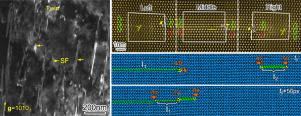当前位置:
X-MOL 学术
›
Acta Mater.
›
论文详情
Our official English website, www.x-mol.net, welcomes your feedback! (Note: you will need to create a separate account there.)
Unexpected partial dislocations within stacking faults in a cold deformed Mg−Bi alloy
Acta Materialia ( IF 9.4 ) Pub Date : 2020-04-01 , DOI: 10.1016/j.actamat.2020.02.010 C. He , Y. Zhang , C.Q. Liu , Y. Yue , H.W. Chen , J.F. Nie
Acta Materialia ( IF 9.4 ) Pub Date : 2020-04-01 , DOI: 10.1016/j.actamat.2020.02.010 C. He , Y. Zhang , C.Q. Liu , Y. Yue , H.W. Chen , J.F. Nie

|
Abstract Stacking faults and the partial dislocations associated with them in a cold-rolled Mg–3wt%Bi alloy have been systematically characterized using transmission electron microscopy and high-angle annular dark-field scanning transmission electron microscopy. Intrinsic stacking faults I2 and I1 are both detected. The I2 fault results from dissociation of a basal 〈a〉 dislocation into two Shockley partial dislocations and exists in both matrix and {10 1 ¯ 2} tension twins. Most of the I1 faults are from dissociation of 〈c + a〉 dislocations, but a small fraction has a structure similar to that of growth I1, and they might result from condensation of vacancies, interstitial precipitation, or coalescence of 〈c + a〉 ribbons. The I1 faults are distributed densely in {10 1 ¯ 2} tension twins but sparsely in the magnesium matrix. They are either bounded by Frank partials or linked to twin boundaries. Unexpectedly, Shockley partials are often found lying at the edge of steps within the I1 faults. Three cases are categorized in terms of the number and the sign of the Shockley partials located in each single I1 fault: one Shockley partial, two Shockley partials having the same sign, and two Shockley partials having opposite signs. The fault bounded by two Shockley partials is explicitly I1 but not I2, which is different from the dissociation of the basal 〈a〉 dislocation. Based on the geometric analysis, two possible mechanisms are proposed to explain the origin of Shockley partials formed in the I1 faults. The mechanism in which basal dislocations react with the bounding Frank partial of I1 is more likely to operate, and this mechanism is supported by molecular dynamics simulations.
中文翻译:

冷变形 Mg-Bi 合金堆垛层错内意外的部分位错
摘要 使用透射电子显微镜和高角度环形暗场扫描透射电子显微镜系统地表征了冷轧 Mg-3wt%Bi 合金中的堆垛层错和与之相关的部分位错。检测到固有堆垛层错 I2 和 I1。I2 断层是由基底〈a〉位错解离成两个肖克利部分位错的结果,并存在于矩阵和{10 1 ¯ 2}张力孪晶中。大部分I1断层来自〈c+a〉位错的解离,但有一小部分具有与生长I1相似的结构,它们可能是由空位凝聚、间隙沉淀或〈c+a〉聚结引起的丝带。I1断层密集分布在{10 1 ¯ 2}张力孪晶中,而在镁基体中分布稀疏。它们要么以 Frank 偏音为界,要么与孪生边界相关联。出乎意料的是,在 I1 断层内的台阶边缘经常发现 Shockley 偏音。根据位于每个 I1 断层中的 Shockley 偏波的数量和符号,分为三种情况:一个 Shockley 偏波、两个具有相同符号的 Shockley 偏波和两个具有相反符号的 Shockley 偏波。由两个 Shockley 偏音界定的断层明确为 I1 而不是 I2,这与基础〈a〉位错的解离不同。基于几何分析,提出了两种可能的机制来解释在 I1 断层中形成的肖克利部分的起源。基底位错与 I1 的边界 Frank 部分反应的机制更有可能起作用,
更新日期:2020-04-01
中文翻译:

冷变形 Mg-Bi 合金堆垛层错内意外的部分位错
摘要 使用透射电子显微镜和高角度环形暗场扫描透射电子显微镜系统地表征了冷轧 Mg-3wt%Bi 合金中的堆垛层错和与之相关的部分位错。检测到固有堆垛层错 I2 和 I1。I2 断层是由基底〈a〉位错解离成两个肖克利部分位错的结果,并存在于矩阵和{10 1 ¯ 2}张力孪晶中。大部分I1断层来自〈c+a〉位错的解离,但有一小部分具有与生长I1相似的结构,它们可能是由空位凝聚、间隙沉淀或〈c+a〉聚结引起的丝带。I1断层密集分布在{10 1 ¯ 2}张力孪晶中,而在镁基体中分布稀疏。它们要么以 Frank 偏音为界,要么与孪生边界相关联。出乎意料的是,在 I1 断层内的台阶边缘经常发现 Shockley 偏音。根据位于每个 I1 断层中的 Shockley 偏波的数量和符号,分为三种情况:一个 Shockley 偏波、两个具有相同符号的 Shockley 偏波和两个具有相反符号的 Shockley 偏波。由两个 Shockley 偏音界定的断层明确为 I1 而不是 I2,这与基础〈a〉位错的解离不同。基于几何分析,提出了两种可能的机制来解释在 I1 断层中形成的肖克利部分的起源。基底位错与 I1 的边界 Frank 部分反应的机制更有可能起作用,


























 京公网安备 11010802027423号
京公网安备 11010802027423号